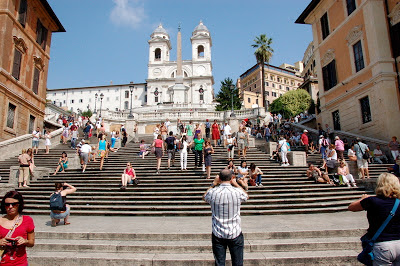Mr Tabubil and I have just returned from three weeks holiday – a week in Holland, so that I might see a bit of his country and meet his family, and two weeks together after that in Italy. Right now, we're in Florence.
With the Pantheon sorted out to American Universalist Satisfaction we took the morning Eurostar train to Florence.
(Buckety buckety pale white horse. Sway in the saddle, sway on the rail, doze at the stations, but stay the course.)
Slipping between wheat-fields and sere golden hills, we snaked through stands of tall grey Cyprus, rounded grey and red-roofed hill-towns and forded stony olive-bottomed river valleys, and two hours later, we were in Florence –swept off the train and tossed out into the gaping stone halls of the Most Over-praised Train Station in Europe.
When I came to Florence nine years ago and looked at the Art Deco Stazione Santa Maria Novella for the first time, I thought that it was a building so uncomfortable and uncomfortable and that it had almost certainly been awarded a major architectural prize.
I was right.
A year of catching local coffee-pot trains out of it twice a week up to Pisa and Prato didn’t change my opinions. Santa Maria Novella was uncomfortable and uncongenial and definitively, wordlessly ‘-un’ in every possible respect.
Eight years further on and with a masters-load of architectural theory under my belt, I can read the fascist declaration of strength and command (we rise up in a statement of industrial and social might as done up in lines of brand-spanking modern architecture and with self-referential historical overtones to remind people of our long and glorious heritage of architectural successes see if we don’t!) that the designers were attempting to make with the building. I can appreciate, in a disinterested way, the clean modern bones of the thing. I can even comprehend – and sympathize a little – with how ivory-tower types could spend the next eighty years going gaga over it.
Nontheless and taking all that into consideration, while the architects of the Tuscan Group who built the Stazione Santa Maria Novella were cheerfully checking off every stylistic ‘x’ in their post-war designer brief, they were completely and totally failing to build a building that is actually pleasant to inhabit. From their lofty post-war-modern heights, they made the dark error of thinking about People instead of actual persons while they were designing. In the station’s dark, drafty, shadowy and echoey, glary and icy, over-heated open-air bowels, there isn’t one iota of indication that this station was ever meant to be anything more than a cardboard model centerpiece in a biennale exhibition somewhere.
And THAT is a rant nine years in the making. Forgive me.
Stazione Santa Maria Novella stands on one edge of the Florence’s old city. We are staying on the other edge of it - down by the river in a third-floor hostel on the Via Borgo Dei Greci.
If you hang out the window and look right you can see the
pink-and-green-and-white marble chocolate box façade of the church of
Santa Croce. After dark, all flood-lit, it loses its chocolate box
aspect and becomes something ALMOST (as much as anything built in the
deep Victorian neo-gothic period can be) awesome and broodingly
nocturnal, and a fitting burial place for the likes of Niccolo
Machiavelli, Lorenzo Ghilberti, Leon Battista Alberti, and Michelangelo
Buonnaroti - far more than it could ever be in the shadow-free mid-day
light!
And I can speak Italian again. I couldn’t in Rome. But the Florentine accent and dialect are completely comprehensible, and roll pleasantly and lilting upon my ear. I haven’t spoken Italian since I left, and what I do speak now is a patchy Spanish-Italian pidgin, but the words are there when I need ‘em and come without the conscious intervention of my fore-brain: half the time I don’t remember the word I need until I’m saying it, and then it rolls out of my mouth and drops into a sentence before I know I’ve said it. At the local grocery i can ask for fruit, and make polite commentary on the weather, and agree that yes, it is quite unseasonably hot and that there ARE far too many tourists in town this season - and so my vocabulary advances!
And I can speak Italian again. I couldn’t in Rome. But the Florentine accent and dialect are completely comprehensible, and roll pleasantly and lilting upon my ear. I haven’t spoken Italian since I left, and what I do speak now is a patchy Spanish-Italian pidgin, but the words are there when I need ‘em and come without the conscious intervention of my fore-brain: half the time I don’t remember the word I need until I’m saying it, and then it rolls out of my mouth and drops into a sentence before I know I’ve said it. At the local grocery i can ask for fruit, and make polite commentary on the weather, and agree that yes, it is quite unseasonably hot and that there ARE far too many tourists in town this season - and so my vocabulary advances!




















